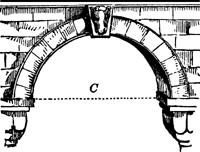chord
Chord
chord
[kȯrd]chord


chord
Chord
the simultaneous combination of several notes of different pitch, auditorily perceived as a unity of sound.
Chords are differentiated by the quantitative and interval composition of the notes which make them up. Basically, a chord’s notes are arranged by thirds, proceeding upward from the lowest tone. Each one has its own name (according to the interval between it and the lowest note): the basic tone or root, the third, fifth, seventh, and so on. The fundamental kinds of chords are the triad (consisting of three different notes), the seventh (consisting of four), the ninth (five), and the eleventh (six). Triads are of four types: major (a major and a minor third), minor (a minor and a major third), diminished (two minor thirds), and augmented (two major thirds). Seventh chords are formed from triads (other than augmented triads) with the addition of a minor or major third above the chord. Sevenths may be major, minor, or diminished, depending upon the interval of the seventh between the extreme notes.
Shifting the notes of a chord—that is, moving the basic tone to one of the higher voices—is called inversion. In such cases the designation of the chord changes. A triad has two inversions (chord of the sixth and six-four chord). A seventh chord has three inversions (five-six chord, three-four chord, and chord of the second). The ninth and eleventh chords are primarily used in their root forms; their inversions have no independent designations. Chords which are built on fourths occur occasionally.
V. A. VAKHROMEEV
Chord
a line segment connecting two points of a curve or surface.